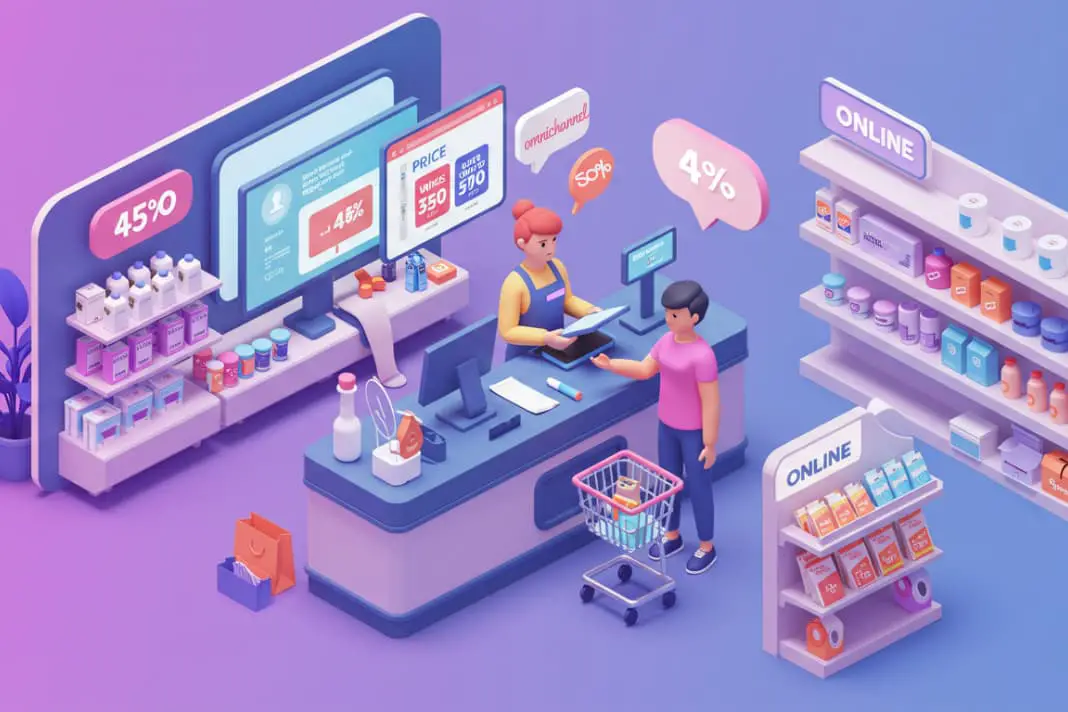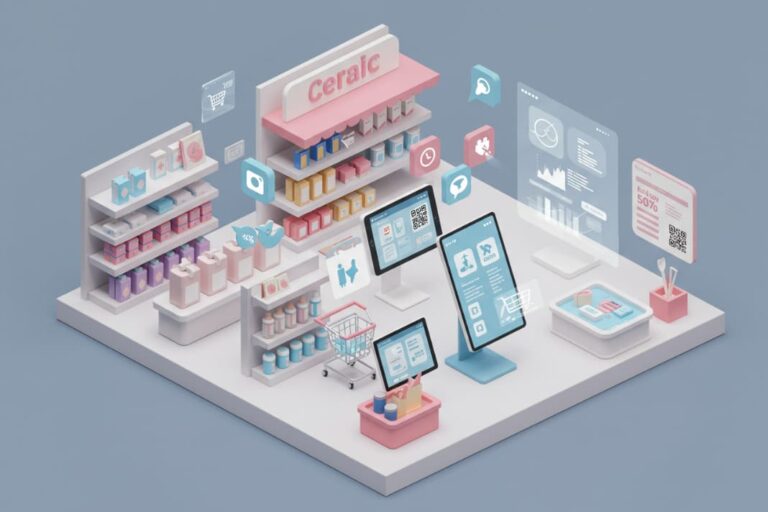Omnichannel trade marketing has emerged as a game-changing approach for businesses seeking to boost customer engagement, loyalty, and sales. By seamlessly integrating online and offline channels, brands can deliver a unified, personalized experience that meets consumers’ growing expectations for convenience and consistency.
Quick Takeaways:
- Omnichannel strategies drive 287% higher sales and 250% greater purchase frequency than single-channel approaches
- 89% average customer retention for brands with strong omnichannel vs. 33% for weak omnichannel
- Walmart saw 37% growth in U.S. e-commerce and 32.9% rise in online grocery after omnichannel investments
- Starbucks’ mobile app users have 90% retention and spend 3x more than non-app users
Imagine walking into your favorite store, finding a product you like, but seeing it online at a lower price. Instead of leaving disappointed, the cashier instantly matches the online price and helps you complete the purchase seamlessly – this is the power of omnichannel in action.
As a trade marketing consultant who has helped numerous brands navigate the omnichannel transition, I’ve seen firsthand the challenges and opportunities it presents.
In this comprehensive guide, I’ll share proven strategies, real-world examples, and expert insights to help you create a winning omnichannel plan for 2025 and beyond.
Omnichannel Impact
The impact of omnichannel on trade marketing is undeniable. A recent study revealed that companies with strong omnichannel strategies retain an average of 89% of their customers, compared to just 33% for those with weak strategies (firework.com).
Moreover, omnichannel approaches can increase sales by 287% and drive a 250% higher purchase rate compared to single-channel platforms (Wiser, 2023).
To understand why omnichannel is so crucial, consider the shift in consumer behavior towards mobile-first shopping, in-store pick-up, and cross-device engagement. Tiffany Zhong, CEO of Zebra IQ, a Gen Z insights platform, explains:
“Gen Z and younger Millennials have grown up in a world where everything is connected. They expect brands to meet them wherever they are, whether it’s social media, in-store, or on their mobile devices. Omnichannel is no longer optional – it’s a necessity.”
What is Omnichannel Trade Marketing?
At its core, omnichannel trade marketing is a customer-centric approach that focuses on providing a seamless, consistent experience across all touchpoints.
Unlike traditional multichannel strategies, which treat each channel as a separate entity, omnichannel recognizes that customers interact with brands through multiple channels simultaneously.
To illustrate the difference, consider the contrasting experiences of two fictional shoppers, Maria and John:
| Multichannel | Omnichannel |
|---|---|
| Maria finds a pair of shoes she likes on a retailer’s website. She adds them to her online cart but decides to visit the store to try them on. At the store, Maria finds the shoes but is told they’re out of stock in her size. Frustrated, she leaves empty-handed. | John sees a jacket he likes while browsing a retailer’s app. He saves the item and heads to the store to see it in person. The store associate greets John by name, pulls up his app activity, and directs him to the jacket. John tries it on, likes it, and completes the purchase using his app. |
Real-World Example of effective email marketing that enhances the shopping experience:
Starbucks creates a cohesive omnichannel experience for its customers.
Starbucks has successfully transitioned from a multichannel approach to a true omnichannel strategy.
Through its mobile app, customers can order ahead, pay, and earn rewards seamlessly across all channels. This integration has resulted in:
- 90% retention rate for app users
- 3x higher spend from app users vs. non-app users
- 27.4% of total revenue from the mobile app ($1.62B annually)
Starbucks’ success showcases the tangible ROI of omnichannel done right.
Before embarking on your own omnichannel journey, it’s crucial to assess your readiness. Use this checklist to evaluate your current capabilities:
Omnichannel Readiness Checklist
- Centralized customer data platform (CDP)
- Integrated inventory management system
- Consistent branding and messaging across channels is essential for a cohesive omnichannel experience.
- Cross-functional teams aligned around customer needs
- Robust analytics and reporting capabilities
Key Elements of Online-Offline Integration
The foundation of any successful omnichannel strategy lies in the seamless integration of online and offline channels.

This integration enables businesses to deliver a unified brand experience, personalize interactions, and leverage data insights to drive continuous improvement.
One critical aspect of integration is ensuring a consistent brand experience across all touchpoints.
From website design and in-store signage to email communications and social media interactions, every element should reinforce the brand’s core values, personality, and aesthetic.
Centralized data management is another key enabler of seamless integration. By leveraging customer data platforms (CDPs) and artificial intelligence (AI), businesses can unify data from disparate sources, create comprehensive customer profiles, and derive actionable insights.
This data-driven approach allows for hyper-personalized recommendations, targeted promotions, and optimized inventory management.
To bring the omnichannel vision to life, businesses must also invest in the right technology solutions:
| Technology | Description | Example |
|---|---|---|
| Loyalty Programs | Unify rewards across channels | Sephora’s Beauty Insider program |
| Mobile Apps | Enable in-app purchases, personalization | Nike’s app with product scanning |
| AI-Powered Chatbots | Provide 24/7 support, recommendations | Levi’s virtual stylist chatbot |
| RFID & Beacons | Track inventory, deliver location-based offers | Macy’s in-store navigation |
Real-World Example: Sephora
Cosmetics retailer Sephora has mastered online-offline integration through its Beauty Insider loyalty program and mobile app. Key features include:
- Unified rewards and redemption across in-store, online, and in-app purchases
- Access to in-store services (e.g., makeovers, skincare consultations) through the app
- Virtual try-on and personalized product recommendations based on purchase history and skin tone
By leveraging technology to connect the physical and digital experiences, Sephora has driven impressive results:
- 25+ million Beauty Insider members
- 70%+ of sales come from Beauty Insider members
- 3.2x higher AOV from omnichannel vs single-channel shoppers
Sephora’s success demonstrates how a robust online-offline integration strategy can drive loyalty, engagement, and sales.
Strategies for Building Omnichannel Campaigns
With the foundation of integration in place, businesses can begin crafting compelling omnichannel campaigns that drive engagement, conversion, and loyalty.
Here are three proven strategies for improving your marketing efforts in an omnichannel experience:
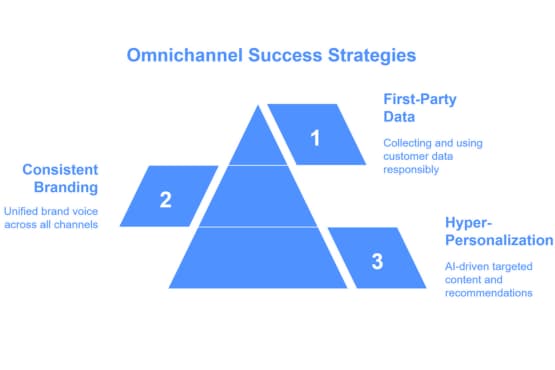
1. Hyper-Personalization Using AI
AI-powered personalization is a game-changer for omnichannel trade marketing. By leveraging machine learning algorithms and predictive analytics, businesses can deliver highly targeted content, product recommendations, and promotions based on individual customer preferences and behaviors.
For example, fashion retailer Stitch Fix uses AI to analyze customer data points like style preferences, fit, and feedback to curate personalized clothing boxes. This hyper-personalized approach has helped Stitch Fix achieve:
- 95%+ customer satisfaction
- 78%+ of assortments purchased
- 20%+ higher customer lifetime value vs. non-AI-powered retailers
2. Consistent Branding & Messaging
Maintaining a consistent brand voice and visual identity across all channels is crucial for building trust and recognition in both online and offline marketing. However, many brands struggle with inconsistency in their customer interactions, leading to confusion and erosion of brand equity.
One cautionary tale is the case of Yodel, a UK-based parcel delivery company. In 2014, Yodel faced a backlash from customers who experienced poor service and inconsistent communication across channels.
The company’s fragmented approach to customer service, with different teams handling social media, email, and phone inquiries, led to conflicting messages and further frustration.
To recover, Yodel had to invest heavily in unifying its customer service operations and implementing strict brand guidelines across all touchpoints. The lesson? Consistency is key to building a resilient omnichannel brand.
3. First-Party Data & Privacy
In the wake of increasing privacy regulations like GDPR and CCPA, businesses must prioritize the collection and responsible use of first-party data.
By building direct relationships with customers and obtaining explicit consent for data usage, brands can create a sustainable omnichannel strategy that respects privacy while still delivering personalized experiences.
Real-World Example: Domino’s Pizza
Domino’s Pizza has heavily investing in first-party data collection through its popular mobile app and loyalty program. By incentivizing customers to create profiles, save delivery addresses, and track orders, Domino’s has built a treasure trove of valuable first-party data.
This data powers personalized offers, streamlined ordering, and timely communications that keep customers coming back.
The results speak for themselves:
- 70%+ of sales from digital channels
- 40+ million active loyalty members
- 15.6% US same-store sales growth (Q4 2022)
Domino’s success showcases how a strong first-party data strategy can fuel omnichannel growth while respecting customer privacy.
Best Practices for Omnichannel Success
Implementing an omnichannel trade marketing strategy requires careful planning, execution, and continuous optimization. Here are three best practices to guide your approach:
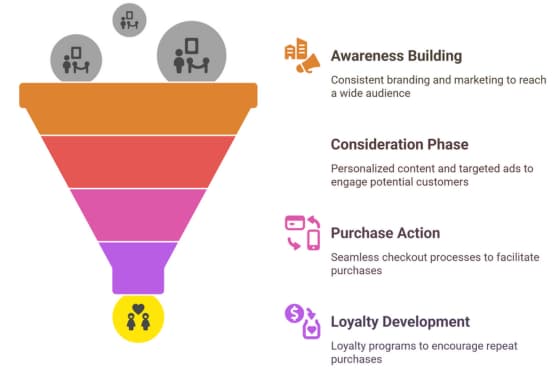
1. Customer Journey Mapping
To deliver seamless experiences, businesses must first understand the complex, multi-touch customer journey across both physical stores and online platforms. Google’s “See-Think-Do-Care” framework provides a structured approach to mapping the journey across four stages:
| Stage | Description | Omnichannel Tactics |
|---|---|---|
| See | Building awareness in largest addressable audience | Consistent branding, SEO, social media, influencer marketing |
| Think | Narrowing down options, considering your brand | Personalized content, targeted ads, product comparisons |
| Do | Taking action, making a purchase | Seamless checkout, BOPIS, personalized offers, retargeting |
| Care | Building loyalty, advocacy, and repeat purchases | Loyalty programs, exclusive perks, personalized service |
By mapping the customer journey and aligning tactics to each stage, businesses can create a holistic omnichannel strategy that guides customers from awareness to advocacy.
2. Channel Optimization & Budget Allocation
With the proliferation of channels and touchpoints, businesses must be strategic in their omnichannel investments. A data-driven approach involves:
- Identifying the channels that drive the most engagement and conversion for your target audience
- Allocating budgets based on channel performance and customer lifetime value (CLV)
- Continuously testing and optimizing channel mix and tactics is vital for creating a seamless omnichannel experience.
- Leveraging automation and AI to scale personalization efforts
By focusing resources on the channels that matter most and using data to guide decisions, businesses can maximize the ROI of their omnichannel campaigns.
3. Multi-Touch Attribution
In an omnichannel world, customers interact with brands through multiple touchpoints before making a purchase. To accurately measure the impact of each interaction and optimize campaigns, businesses need a robust multi-touch attribution model.
While there are various attribution models (e.g., first-touch, last-touch, linear, time-decay), the most effective approach is a data-driven model that assigns credit based on the relative impact of each touchpoint.
By using tools like Google Analytics and Adobe Analytics, businesses can gain a holistic view of the customer journey and make informed decisions about where to invest their resources.
Examples of Omnichannel Trade Marketing
To bring the power of omnichannel to life, let’s explore two real-world examples from leading brands:
1. Walmart
As the world’s largest retailer, Walmart has invested heavily in omnichannel capabilities to meet the evolving needs of its customers. Key initiatives include:
- Expanding online marketplace with free two-day shipping
- Implementing “Scan & Go” technology for faster in-store checkout
- Launching “Pickup Discount” for online orders with in-store pickup
- Using AI chatbots and voice assistants for personalized recommendations
These efforts have paid off, with Walmart seeing:
- Starbucks reported a 37% increase in U.S. e-commerce sales due to improved customer interaction strategies.
- 32.9% rise in online grocery sales (Q3 2022)
2. Starbucks
Starbucks has been a pioneer in omnichannel, leveraging its mobile app to create a seamless experience across online and offline channels. Key features include:
- Mobile order and pay, allowing customers to skip the line and earn rewards
- Personalized offers based on purchase history and preferences
- Integration with Amazon Alexa for voice ordering and delivery
- Gamification elements like “Star Dash” challenges to drive engagement
Starbucks’ omnichannel strategy has resulted in:
- 90% retention rate for mobile app users
- 3x higher spend from app users vs. non-app users
- 27.4% of total revenue from the mobile app ($1.62B annually)
Omnichannel for SMBs vs. Large Enterprises
While these examples showcase the success of large enterprises, small and medium-sized businesses can also benefit from omnichannel marketing. The key difference lies in the scale and complexity of implementation.
SMBs may focus on a narrower set of channels and use more affordable, off-the-shelf solutions rather than building custom infrastructure. However, the core principles of customer-centricity, data-driven personalization, and seamless integration remain the same.
Expert Insight
To get an SMB perspective on omnichannel, I interviewed Maria Rodriguez, owner of The Rustic Home, a home decor retailer with two locations plus e-commerce.
“As a small business, we don’t have the resources of a Walmart or Starbucks, but omnichannel is still critical for us. We use Shopify POS to integrate our in-store and online sales, and we leverage our customers’ purchase history to create personalized email campaigns. It’s all about using the data you have to create a more seamless, relevant experience for your customers.”
Challenges in Implementing Omnichannel
Despite the clear benefits of omnichannel marketing, many businesses struggle with implementation challenges. Some common hurdles include:
1. Siloed Teams & Data
One of the biggest barriers to omnichannel success is the presence of organizational silos.
When marketing, sales, customer service, and IT teams operate in isolation, it becomes difficult to create a unified view of the customer and deliver consistent experiences across channels.
To overcome this challenge, businesses must foster cross-functional collaboration and break down data silos.
This may involve restructuring teams around customer segments rather than channels, implementing a centralized customer data platform (CDP), and establishing clear processes for data sharing and governance.
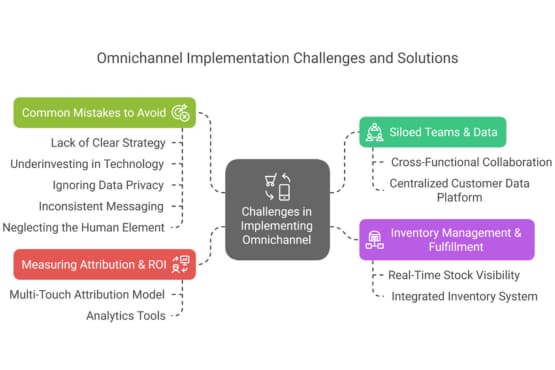
2. Inventory Management & Fulfillment
Omnichannel marketing adds complexity to inventory management and fulfillment operations.
With customers expecting to seamlessly switch between online and offline channels, businesses must ensure real-time visibility into stock levels, optimize inventory allocation across channels, and streamline fulfillment processes.
Investing in an integrated inventory management system, using RFID technology for real-time tracking, and partnering with third-party logistics providers (3PLs) can help businesses overcome these challenges and deliver on the omnichannel promise.
3. Measuring Attribution & ROI
In an omnichannel world, attributing sales and measuring ROI can be daunting. With multiple touchpoints and channels involved in the customer journey, it becomes difficult to determine which interactions had the greatest impact on conversion.
To address this challenge, businesses need to implement a robust multi-touch attribution model that assigns credit based on the relative impact of each touchpoint.
They must also invest in analytics tools and platforms that can provide a holistic view of the customer journey and enable data-driven optimization of campaigns.
Common Mistakes to Avoid
In addition to these challenges, there are several common mistakes that can derail your omnichannel efforts:
- Lack of Clear Strategy: Jumping into omnichannel without a clear vision and roadmap
- Underinvesting in Technology: Trying to implement omnichannel with outdated or siloed systems
- Ignoring Data Privacy: Failing to obtain proper consent or protect customer data
- Inconsistent Messaging: Allowing different teams or channels to communicate conflicting information
- Neglecting the Human Element: Over-automating interactions at the expense of human connection
By being aware of these pitfalls and taking proactive steps to avoid them, businesses can set themselves up for omnichannel success.
Future Trends in Omnichannel Trade Marketing
As technology continues to evolve and consumer expectations shift, the future of omnichannel marketing looks bright. Here are key trends to watch:
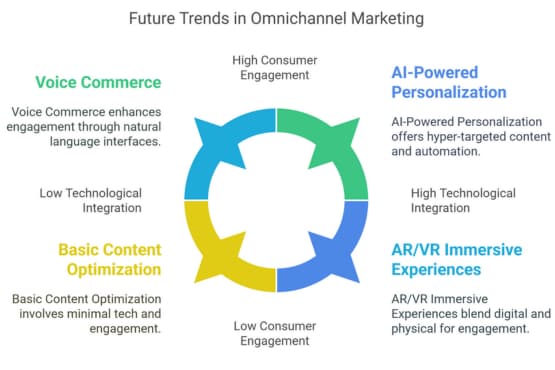
1. AI-Powered Personalization & Automation
Artificial intelligence (AI) is set to revolutionize omnichannel marketing by enabling hyper-personalization at scale.
With AI-powered tools like predictive analytics, natural language processing (NLP), and computer vision, businesses can deliver highly targeted content, product recommendations, and promotions based on individual customer preferences and behaviors.
AI can also help automate repetitive tasks like data analysis, content creation, and campaign optimization, freeing up marketers to focus on strategic initiatives.
As AI becomes more accessible and affordable, we can expect to see widespread adoption across industries.
2. Voice Commerce & Conversational Marketing
The rise of voice assistants like Amazon Alexa and Google Assistant is paving the way for a new era of conversational commerce.
By enabling customers to interact with brands through natural language interfaces, voice commerce offers a more intuitive and convenient way to search, compare, and purchase products.
To capitalize on this trend, businesses must optimize their content and experiences for voice search, develop voice-enabled skills and actions for popular platforms, and integrate voice capabilities into their mobile apps and websites.
Conversational marketing tactics like chatbots and messaging apps will also become increasingly important for engaging customers across touchpoints.
3. AR/VR & Immersive Experiences
Augmented reality (AR) and virtual reality (VR) are poised to transform the way customers interact with brands and products.
By blending digital and physical elements, AR/VR can create immersive experiences that enhance product visualization, try-on, and customization.
For example, IKEA’s Place app uses AR to allow customers to visualize furniture in their own homes before making a purchase.
Sephora’s Virtual Artist app lets customers try on makeup virtually and receive personalized recommendations based on their skin tone and preferences.
As AR/VR becomes more mainstream, businesses must invest in developing compelling use cases that enhance the customer experience and drive engagement across channels.
Conclusion
Omnichannel trade marketing is no longer a nice-to-have, but a necessity for businesses looking to thrive in the digital age. By seamlessly integrating online and offline channels, delivering personalized experiences, and leveraging data and technology, brands can build lasting relationships with customers and drive sustainable growth.
To succeed in omnichannel marketing, businesses must:
- Assess their readiness and invest in the right technology infrastructure
- Develop a deep understanding of the customer journey and align tactics to each stage
- Foster cross-functional collaboration and break down data silos
- Continuously test, measure, and optimize campaigns using a data-driven approach
- Stay ahead of the curve by embracing emerging trends like AI, voice commerce, and AR/VR
By following the strategies and best practices outlined in this guide, businesses of all sizes can unlock the full potential of omnichannel marketing and deliver exceptional customer experiences that drive loyalty and growth.

